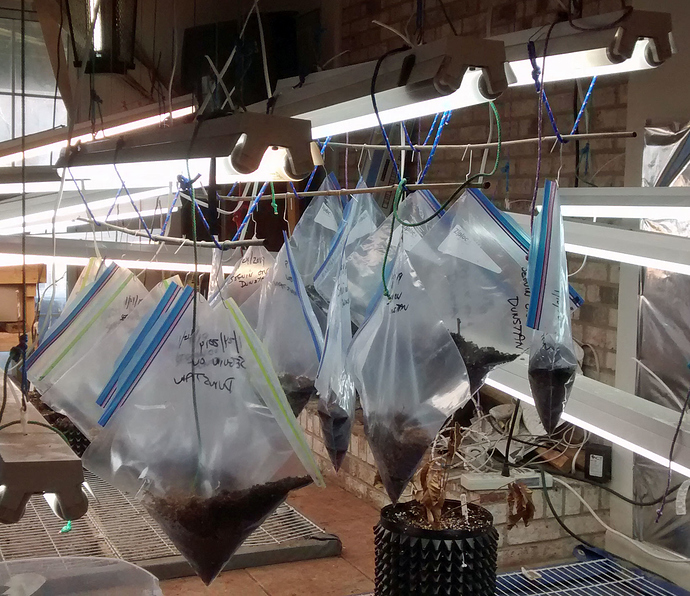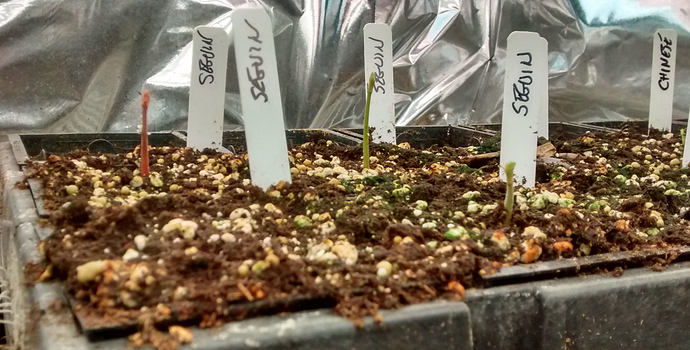If I ever get that far with nut grafting, I certainly will!
Seguins generally will not graft to other castanea species. If you can get a graft to take it will usually die within a few years.
Auburn’s patented trees are reproduced through grafting.
I think root grafts eventually become self rooted, keeping in mind that there are basically 3 different types of root grafts.
Here’s a thought, grin, take it as a thought experiment…
Buy or make some pollination bags. Tyvek house wrap can be sewn up to make a long skinny bag that works. Hand pollinate a mollissima or a dentata with seguini pollen and grow out the nuts. There will be some nuclear genes from the seguini and those nuts may be more compatable for grafting.
If that’s not the case, use seguini as the seed parent, use dentata pollen, then grow out those nuts so the haplotype matches. You will be 5 or 10 years delayed if you have to go that route, and you might even be able to get some seednuts that have the chinkipin haplotype already. Some chestnuts (dentatas) make have crossed with chinkipins in the deep past, and you could look up chestnut haplotypes on line to see where that was most likely to have happened, or if some one already has some to share.
Well, I think something similar is actually happening right now. I say I have Dunstan chestnuts, but that is really shorthand. The original Dunstan chestnut was a cross and cross-back between American and Chinese that was patented. The name Dunstan chestnut then became a trade-name registered by Chestnut Hill and they actually sell seedlings under the name Dunstan.
My “Dunstan” trees were grown from seed that was collected from an orchard that planted Dunstan chestnuts many years ago. Since it is my understanding that pretty much anything from the chestnut family can pollinate anything else from the chestnut family except itself (or a clone), the nuts I got were pollinated by something in the chestnut family at the orchard; who know what.
So, my “Dunstan” trees are just beginning to come online. There can be a big difference between how fast individual trees grow. I’m sure some has to do with the environmental conditions, protections, resources available, and some has to do with genetics.
Since these are wind pollinated, some of the first trees to produce nuts were effectively sexually isolated from other “Dunstan” (seedlings) I’ve planted because the trees nearby are not mature enough to produce catkins. However, I do have a many Allegheny Chinquapins growing wild on my land. I’m pretty sure to only candidate pollinator trees are the ACs.
These are the nuts I’m using for nut grafting. Some may be compatible or none may be compatible with seguinii. I really have no idea what the mix of genetics really is. So while not done by bagging and selective pollination, what you suggest may be functionally happening.
If none of them take it will be disappointing, but I’ll still enjoy the process. If a couple take and even if they only live a few years, I’ll be elated!
That’s it, isn’t it, fun along the way.
For me, growing seedlings is just about having fun, and seeing what you can get. You never know when something special will pop up.
The primary Dunstan cultivars were Revival, Carolina, Willamette, Carpenter, Alachua, and Heritage. Heritage had some American qualities. The others were largely Chinese. Revival probably produces the best seedlings but we don’t know the parents of the trees currently being sold as Dunstan seedlings.
The Dunstan trees were bred using the alleged American tree and the three Chinese cultivars Meiling, Kuling and Nanking. All three Chinese trees are fairly vigorous and very blight resistant. None had very special nut quality which is why you run across so few Dunstan seedlings with great nut quality. Basically when you buy Dunstan seedlings you are buying a somewhat inbred group of seedlings. They really should be outcrossed to different unrelated cultivars that have better nut quality.
Well, I had a lot of scions left over after grafting the nuts from my Dunstan trees, so I decided to expand the project. I ordered a dozen germinated Dunstan nuts off ebay. Who know what you’re really getting when you buy this way, but I figured I’d give it a shot. The nuts arrived today. They included an extra one for a total of 13 and all had root radicles. If these are actually nuts from Dunstan trees, they are the runts of the litter. There is a lot of variety in Dunstan nut size so they could be Dunstans but they sure are tiny.
This is problematic because the scions I have left are pretty large. I nut grafted all 13 nuts tonight, but I’m not expecting much from these. In some cases, the nuts even cracked slightly because of the size of the scions. You never know, so I didn’t junk them, but I don’t have high hopes for this batch.
I’ll be fortunate if any of these take, but especially if I get any from this second batch.
Good luck. You need nuts like this -
These are Szego nuts. The pollen parent for Szego was probably the Dunstan cultivar Revival.
You can sometimes buy Szego nuts from Empire Chestnuts in Ohio or Red Fern Farm nursery in Iowa. The University of Missouri was selling them last year along with the dozens of other nuts they sell, but they charged a higher price for Szego.
You can buy Szego trees from One Green World, but they’re pricy-
https://onegreenworld.com/product/szego-grafted-chestnut-tree/
OGW thinks Szego is European x Chinese but it’s not. It’s mostly Japanese x Chinese.
My Dunstans are not quite that big, but the large ones are getting close. Back when I was starting Dunstans from nuts in volume every year, I was getting my nuts from Chestnut Ridge of Pike County. The average size nuts I got from them were much larger than the tiny ones I got of ebay, but I would get them in October and cold stratify them myself. This was kind of a last minute addition to the project and I had to get nuts that were already stratified. Ebay was the only option I could think of.
I’m thinking that nut grafting Seguins to European or Japanese crosses would be an even bigger stretch.
That would be funny.
I would think it would be hard to find a scion thin enough to graft to a new seedling shoot like that.
When I’ve grown oaks from seed, the initial shoot is always thinner than the average one-year-old growth on a mature oak.
You do need to pick and choose, and I do often need to wait till the shoot/root thickens. Sometimes I graft into the hypocotle, or even the inverted radicle, if it’s bigger. Quite often the root collar area is big enough, and with parafilm tape, you can tape that low and the roots will grow out through it anyway.
The other issue, is that I need potted trees small enough to bring to a nut meeting, which is usually out of province.
If you ease a scion into a cut nut at room temperature, it is less likely to split. Cold nuts split easier, and it’s better if they don’t.
Look at this cut nut, even though it’s a small nut, you could ease a scion into it gently…push it in slowly so it gives instead of splitting.
I’m direct nut grafting rather than inverted radicle or epicotyle grafting. With this I’m jamming the scion directly into the nut. I find 1/8" diameter scions work well with most chestnuts. Larger ones require larger nuts. 1/4" seems to be about the practical limit.
Well, the nut grafts are not looking too good. I did not expect much. They say it is very hard to graft Seguins to any other chestnut. We still have 10 more days until the first grafts are a month old. I’m not seeing any bud swell on any yet. I have at least one that is putting up top growth from the nut, which of course will be Dunstan if I let it grow, but no seguin success. I decided to give them more light to see if that helps. So, today I attached bamboo to the lights and hung them from the bamboo:
On a positive note for Seguins, 3 of the 4 nuts I planted have produced top growth. Only one of the 4 Chinese chestnuts have done so:
Can you give them a little more heat? Sometimes heat speeds them up. Also, at 20 days, they may need more time.
Has anybody tried or had luck with grafting chestnuts to Bur Oak or European Beech? I ask because chestnuts hate the alkaline clay soil in the mountain west but some reports say the two above trees can be used for root stock and they are both adaptable to the soil.
They are in my heated basement that is nominally 70 degrees. I realize 20 days is too soon to expect much. Mayfield says he checks them for roots and swelling buds at 1 month. They will probably be a few degrees warmer now that they are under lights.
I had an old grafter tell me that he was experimenting with grafting chestnuts to sawtooth oaks. It has been a few years since I heard from him. The last I had heard from him, he told me grafts took and the trees lived for several years but then died. He assumed some incompatibility.
If the first batch of nuts had no root yet, they may have taken a little time to wake up. This can delay growth.
It can also lower the success rate, as sometimes the scion dies before the nut is ready to make callous.
Sometimes it’s fine. it will be interesting to see if there is any practical difference between the first and second batch of nuts, given the roots were out on the second ones. I have never worked with seguinii, so that wil be fun to see how it works out too.
Love that red one.




